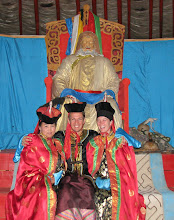Arapaho Native American
Arapaho

The Arapaho, "he who trades," inhabited eastern Colorado and southeastern Wyoming, in the tallgrass along the headwaters of the Platte and Arapaho rivers. In the winter these locales offered shelter from trees along the waterways, good water and wild game habitat for food. In summer, the tribe became nomadic, following the massive herds of buffalo.
The need for travel to follow food sources, the Arapaho, like many plains tribes, lived in tipis. Made from buffalo hides sewn together and wrapped around a circular frame of lodgepoles, the tipi was easily collapsed and packed in the event of a herd sighting or danger approaching. In the early days, the move was made on foot, with equipment and belongings being being "carried" by dogs pulling a drag cart made of lodgepoles and hides called a travois. Later, after the Spanish brought the horse to the plains, a larger version of the travois was used with the horse.
Each buffalo hunt was preceded and followed by ceremony for good luck in the hunt before and thanksgiving after, as the buffalo supplied the Arapaho with just about all their needs. Clothing, tools, food, shelter all came from the buffalo, as all parts of any animal killed was always tried to be utilized. Their diet was subsidized with berries and plants, and buffalo was often dried and pounded together with berries and buffalo fat to make pemmican, a staple of the people. Other plains tribes sometimes referred to bands of Arapaho as "dog eaters," as it is said they ate dog flesh as routine.
Standard clothing included deer or elk skin breechcloths for the men, with hide shirts, leggings and moccasins. Women wore deer or elk skin dresses, often fringed, which provided instant access to leather lacing for lashing and also kept bugs at bay when the women walked the prairie. In winter, buffalo robes added warmth. Often clothing was beautifully adorned with porcupine quill or bead work, which the women had time to do during the long winters in the tipi.
Like most Indians of the great plains, the pipe held deep religious and social status among the Arapaho and they also shared ceremony like the Sundance and sweatlodge.
In the early 1800s some Arapaho tribe members joined bands of Kiowa and Comanche in a fight against the Cheyenne. The rest of the tribe went north and actually joined the Northern Cheyenne in their fight against the Lakota (Sioux). Eventually all the Arapaho were gathered up and placed on a reservation in Indian Territory, but the Northern Arapaho band did not like the lands selected for them, so they moved to Wyoming to live among the Shoshone on their reservation. The Arapaho who remained on the Indian Territory reservation eventually lost out totally, as their reservation was subdivided among tribe members and white settlers who wanted to buy and own the land.
Today, descendents of the Arapaho live on the Wind River Reservation in Wyoming where they primarily raise cattle. Some also live in Oklahoma


0 Comments:
Post a Comment
Subscribe to Post Comments [Atom]
<< Home